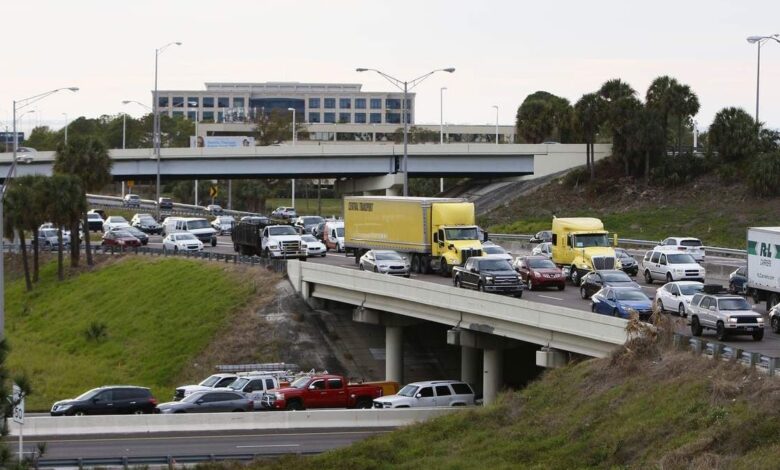Planes, trains and automobiles: Why Tampa Bay needs a new tri-county planning group

When we work together, we can achieve what no individual, organization or county can accomplish alone. Tampa Bay must address long-standing transportation infrastructure needs, including better regional connectivity. This is why Tampa Bay needs a new Tri-County Metropolitan Planning Organization, which would serve Hillsborough, Pasco and Pinellas counties.
I am the president of the Tampa Bay Partnership, a coalition of regional business and nonprofit leaders working together to improve Tampa Bay residents’ personal and economic well-being. And I have spoken with many regional leaders who stress the importance of acting together — as one region — on transportation.
Joe Lopano, CEO of Tampa International Airport and 2024 chairperson of the Tampa Bay Economic Development Council, told me that “the time is overdue for us to speak from one powerful voice with one goal: to improve mobility, connectivity and transit options for this rapidly growing region. Regional collaboration has been key to our success in attracting new airline routes and positioning ourselves as a global destination. We need to apply the same strategy to funding solutions we desperately need for those who live, work and play here.”
At the Tampa Bay Partnership, we compare ourselves to similar communities across the United States. This year, Tampa Bay had the most net migration of all of our comparison communities. The region’s glowing reputation continues to attract new residents and businesses, and more than 3.5 million people are projected to move into the three-county area by 2035.
There is more. Over 1 in 5 of Tampa Bay workers commute across county lines daily.
Limited public transit options and poor regional connectivity exacerbate congestion and long commute times. Changing travel patterns and increased growth on the Lee Roy Selmon Expressway have exceeded 2019 pre-COVID projections, with 20% growth in traffic, according to the Tampa Hillsborough Expressway Authority. The Selmon West Extension over Gandy Boulevard has already reached 2030 traffic predictions. We must take action to advance and improve existing infrastructure for our workers, employers and residents.
Port Tampa Bay employs staff from Hillsborough, Pasco and Pinellas counties, and its leaders understand that a robust transportation system contributes to job satisfaction and improves quality of life. Paul Anderson, Port Tampa Bay president and CEO, has expressed to me that “Port Tampa Bay is proud to serve our region and community. As West Central Florida’s single largest economic driver, we see the value of strengthening infrastructure for current residents and as a way to attract talented staff and businesses to relocate to Tampa Bay.”
If we successfully reimagine our transportation planning approach, we will have the largest Metropolitan Planning Organization by population in the state, with almost 3 million residents.
Spend your days with Hayes
Subscribe to our free Stephinitely newsletter
Columnist Stephanie Hayes will share thoughts, feelings and funny business with you every Monday.
You’re all signed up!
Want more of our free, weekly newsletters in your inbox? Let’s get started.
Given our sheer size, regional funding requests will be more likely to succeed simply because they impact more Florida residents. Our volume of residents will improve our likelihood of obtaining significant dollars for transportation projects.
Furthermore, federal regulations and state statutes are in favor of communities forming regional Metropolitan Planning Organizations, a practice that is widely used across the nation.
Greg Slater, CEO and executive director of Tampa Hillsborough Expressway Authority, has experienced the benefits firsthand. During his career, he worked with many MPOs, including the National Capital Region Transportation Planning Board, which consisted of two states and the District of Columbia, eight counties and 14 municipalities and urbanized areas; and the Baltimore Regional Transportation Board, which covered six counties and Baltimore City.
He told me that “regardless of the size of the regional MPO, the focus was truly the success of the region balanced with voicing the needs of each jurisdiction. Tampa Bay is growing at a rapid pace, and to succeed, we will need all transportation options in the conversation to benefit all the residents and businesses we serve. To that, we must collaborate on these opportunities as a cohesive region.”
State legislators have consistently shared that the Tampa Bay region has a disjointed message, with counties advocating for disparate interests and piecemeal funding requests. A regional Metropolitan Planning Organization can present a collaborative priority list for federal and state dollars. Regional scope uplifts projects that benefit all in the region.
This year, directors from PlanHillsborough, ForwardPinellas and the Pasco Metropolitan Planning Organization approved a version of the drafted memorandum of understanding for a Tri-County MPO. Local county commissioners have held two Tri-County Commission meetings. Now, more than ever before, we see a willingness to think regionally and collaborate for the good of all of our residents.
We win when we work together. Regional support helped us to earn $1 billion in funding from the governor and Legislature for the Westshore Interchange, which supports residents and commuters from across Tampa Bay. A Tri-County Metropolitan Planning Organization opens the door for similar success.
The time is right, conditions are ready, and the benefits are clear. For these reasons, we regional leaders strongly support the creation of a regional Metropolitan Planning Organization.
Bemetra Simmons is president and CEO of the Tampa Bay Partnership, a coalition of regional business and nonprofit leaders working together to improve Tampa Bay residents’ personal and economic well-being.



